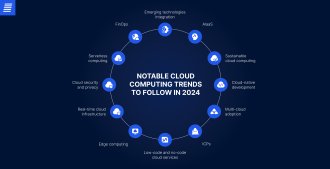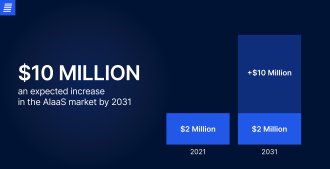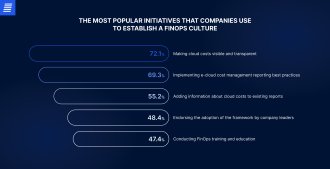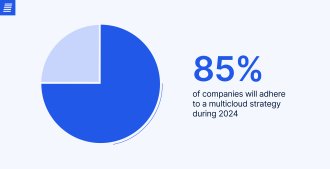
Contact us
Our team would love to hear from you.

Companies are increasingly recognizing cloud computing technology as the cornerstone of contemporary information technology (IT), lying at the heart of the digital transformation process. Cloud computing never ceases to develop and expand, accommodating the diversifying needs of businesses across various sectors. According to Mordor Intelligence, the cloud computing market is predicted to grow from $680 billion in 2024 to $1.44 trillion in 2029, with a CAGR of 16.40% over the forecast period. In this article, we explain the concept of cloud computing and explore its most significant trends that everyone must be ready for in the near future.


Source: Mordor Intelligence
In essence, cloud computing is the on-demand delivery of computing resources over the internet. These resources include databases, software, storage, servers, networking, analytics, and more. Companies can host applications on public, private, and hybrid clouds, supporting various computing services through models, such as infrastructure-as-a-service (IaaS), platform-as-a-service (PaaS), and software-as-a-service (SaaS). Below is a brief breakdown of what each cloud service model entails:
Organizations harness the capabilities of cloud computing infrastructure for a wide range of use cases, including disaster recovery, data backup,software development and testing, real-time fraud detection, and more. The benefits of using this technology are boundless. Companies capitalize on cloud services to increase the scalability, agility, flexibility, and elasticity of their IT infrastructure and operations. Other perks of leveraging cloud computing resources include significant cost savings, enhanced security, lightning-fast performance, and improved productivity.
As a multifaceted and mainstream technology, cloud computing is continuing to evolve in leaps and bounds. What, though, does the cloud computing future hold? Let’s discover what emerging cloud trends we can expect in the coming years.


Cloud computing is playing a pivotal role in democratizing AI, making it more accessible to businesses. To avoid substantial expenditure on extensive computing resources, companies turn to various cloud providers that offer AI-as-a-service (AIaaS) functionalities over the cloud through a subscription business model. This new paradigm empowers businesses to unlock the transformative potential and capabilities of artificial intelligence services, such as machine learning (ML), natural language processing (NLP), and third-party APIs. According to a report by Business Research Insights, the AIaaS market is predicted to grow from nearly $2 million in 2021 to over $12 million by 2031.


Source: Business Research Insights
Cloud computing is the major force behind not only AI but also other emerging technologies, such as blockchain, the Internet of Things (IoT), quantum computing, and more. In most cases, integrating these advancements with cloud computing doesn’t require massive investment in specialized hardware, software, and infrastructure. It also brings a plethora of other significant advantages. Thus, incorporating blockchain into cloud platforms increases the transparency and security of cloud-based transactions while ensuring data integrity and traceability within cloud environments. By providing a more scalable cloud infrastructure, cloud computing facilitates the monitoring of IoT devices and sensors, enabling real-time data analytics and insights to enhance the decision-making process. Although quantum computing is still in its nascent stage, integrating it into cloud platforms can significantly enhance the computational power of the cloud. It can also facilitate the development of quantum algorithms, simultaneously driving cloud innovation.
The adoption of the FinOps framework is another significant trend in cloud computing. FinOps is a cultural practice used by businesses to promote shared accountability for cloud expenses. The primary goal of this practice is ensuring that companies boost the business value of their cloud investment. To achieve this goal, organizations assemble their cross-functional teams from technology, finance, and business departments to collaboratively reach efficient cloud spending decisions. Based on an analysis by the FinOps Foundation, businesses can foster a FinOps culture by using multiple initiatives, as set out below:


Source: FinOps Foundation
The significant shift toward sustainability is apparent in all facets of our lives, and technology is no longer an exception. Sustainable cloud computing, otherwise known as green cloud computing, is exactly what giant cloud providers are striving to achieve in the coming decades. Among the most effective initiatives to drive green cloud computing are optimized energy consumption, the use of renewable energy to power cloud data centers and improve operational efficiencies, e-waste minimization, and more. Launching sustainable cloud computing initiatives will ultimately lead to a significant reduction in customer carbon footprints and the achievement of net-zero emissions.
Essentially, cloud-native development focuses on creating, deploying, and managing applications directly in cloud environments. To build robust software applications in the cloud, developers use microservices architecture instead of a monolithic structure. They also capitalize on a multitude of technologies, such as containerization and service mesh, and adhere to various DevOps best practices. Developing cloud-native applications offers businesses a wide range of competitive advantages. It helps increase operational efficiencies, reduce infrastructure-related costs, and drive immense levels of scalability and flexibility. Improved resilience and fault tolerance contribute to the high availability and reliability of cloud-native solutions anytime, anywhere, delivering positive customer experiences.
When discussing the most popular cloud computing trends, it’s impossible not to mention low-code and no-code cloud services. Based on the idea of simplified cloud computing, this trend is currently gaining momentum. It allows individuals with limited or no technical knowledge to build, deploy, and manage applications using low-code and no-code cloud resources. Such resources accelerate the development process, reduce app-building costs, and empower users to create efficient solutions despite insufficient coding experience.

We developed a groundbreaking platform that enables creators to design gamified voice-driven interactive experiences, empowering viewers to decide how the story unfolds.
With public clouds having dominated the cloud computing market for years, companies have felt a massive need for an optimal cloud paradigm to accommodate their specific workloads and data types. This need has prompted them to adopt the multicloud model, which is now becoming an increasingly popular cloud trend. The multicloud model involves using cloud computing services from several providers, including any combination of public, private, and hybrid cloud solutions. This comprehensive approach to cloud computing allows organizations to optimize cloud services based on their exact needs, avoid vendor lock-in, and enjoy increased levels of both flexibility and cost-effectiveness. According to Forbes, up to 85% of companies will adhere to a multicloud strategy in 2024.


Source: Forbes
Serverless computing is a significant cloud computing trend that has gained a lot of traction recently. At the core of serverless computing lies the function-as-a-service (FaaS) model. It allows software developers to run snippets of code as individual functions without needing to manage the underlying infrastructure, servers, back-end configurations, or other elements. This indicates that cloud providers handle all these aspects by themselves, charging clients only for the number of times their code runs on a serverless server using a pay-as-you-go (PAYG) pricing model. Serverless computing offers enterprises countless opportunities to minimize operational costs, expedite development, and reduce latency. It also ensures quick application testing, fixing, deployment, and updates.
Edge computing is another prominent computing trend we’ve been seeing lately. Enhanced by cloud computing, IoT, and 5G networks, edge computing focuses on processing, analyzing, and storing real-time data close to the sources where this data is being generated and collected. Such sources are typically located near the network edge, including IoT devices and sensors. The decentralized nature of edge computing allows companies to reap multiple benefits. Some of its advantages include low latency, driving more efficient and rapid data processing; reduced costs; and the extraction of real-time insights. According to Statista, the global edge computing market will reach a staggering $274 billion by 2025.
In today’s data-driven digital age, companies require real-time data to accelerate the extraction of instantaneous insights and guide informed decision-making. To accomplish this, they are transitioning to real-time cloud infrastructure powered by the convergence of computing technologies, such as serverless computing and edge computing. Real-time cloud infrastructure facilitates processing and analyzing continuous data streams in real time, providing immediate responses to various events, changes, and fluctuations. Migration to real-time cloud infrastructure offers numerous perks, including minimizing latency, improving operational efficiencies, and elevating customer experiences.
Industry cloud platforms (ICPs) is another emerging trend in the realm of cloud computing that organizations shouldn’t overlook. In a broad sense, ICPs are cloud computing platforms designed to meet the specific requirements of particular industry verticals, including healthcare, finance, manufacturing, retail, and more. ICPs integrate IaaS, PaaS, and SaaS into a unified platform and combine these models with numerous business approaches to address vertical-specific challenges and offer efficient solutions. Salesforce, Azure IoT Suite, and IBM Sterling Supply Chain Suite are some prominent ICP examples. According to Gartner, over 70% of companies will integrate ICPs into their business initiatives by 2027.
In the ever-evolving and intricate cybercrime landscape, fortifying digital defenses in the cloud isn’t merely a trend, but rather a vital necessity emphasized by multiple businesses. To maintain high levels of security and privacy within cloud environments, organizations must plan and implement a wide range of preventive activities against potential cyberthreats. These activities can include building robust risk mitigation strategies, following security best practices, and conducting constant vulnerability assessments. Other critical tasks aimed at safeguarding sensitive data in the cloud involve employing a broad spectrum of security measures, including data encryption, authentication, disaster recovery, and more.
“It’s been just a short time since the widespread adoption of microservices, and DevOps and CloudOps, as a specific case, have taken over almost the entire spectrum of automation across all areas of development. I am confident this trend will only continue to grow.”
Group Manager of DevOps Department
Cloud computing exerts a profound impact on every aspect of our lives, including business, technology, and everyday activities. As evidenced by the cloud computing trends discussed in this article, this impact is only expected to grow. If you haven’t initiated cloud migration yet, now is the best time to take action. Contact us as soon as possible, and our skilled CloudOps specialists will develop a comprehensive and robust cloud migration strategy tailored to your specific business demands and budget. Rest assured that with our in-depth expertise and ongoing support, migration to the cloud will be smooth and effortless, ultimately delivering a plethora of proven benefits to your business, including automation, scalability, security, and cost-efficiency.

Simply put, cloud computing is the delivery of computing resources on demand via the Internet.
Cloud computing includes public, private, and hybrid clouds, supporting various computing services through IaaS, PaaS, and SaaS models.
There are several reasons why numerous businesses have made significant investments in cloud computing. By adopting cloud infrastructure, organizations can increase the scalability, agility, flexibility, and elasticity of their operations. They can also enjoy significant cost savings, enhanced security, lightning-fast performance, and improved productivity.
Popular trends in the cloud computing realm will include AIaaS, emerging technologies integration, FinOps, sustainable cloud computing, cloud-native development, and low-code and no-code cloud services. Other notable trends will encompass multicloud adoption, serverless computing, edge computing, real-time cloud infrastructure, ICPs, and cloud security and privacy.
Can’t find the answer you are looking for?
Contact us and we will get in touch with you shortly.
Our team would love to hear from you.
Fill out the form, and we’ve got you covered.
What happens next?
San Diego, California
4445 Eastgate Mall, Suite 200
92121, 1-800-288-9659
San Francisco, California
50 California St #1500
94111, 1-800-288-9659
Pittsburgh, Pennsylvania
One Oxford Centre, 500 Grant St Suite 2900
15219, 1-800-288-9659
Durham, North Carolina
RTP Meridian, 2530 Meridian Pkwy Suite 300
27713, 1-800-288-9659
San Jose, Costa Rica
Escazú Corporate Centre, Piso 6
40602, 1-800-288-9659